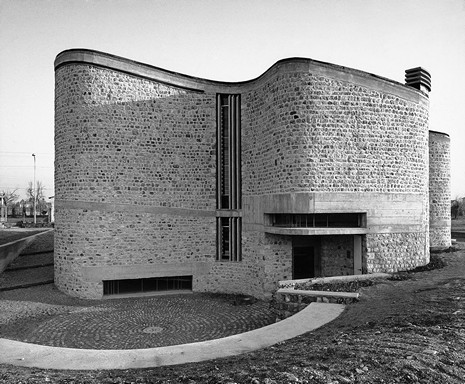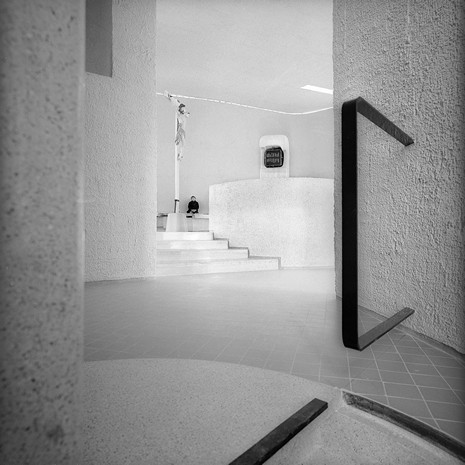Description
From the mid-fifties to the end of the sixties, due largely to the “Centro di Studio e Informazione per l‘Architettura Sacra” and the journal “Chiesa e Quartiere,” Bologna became a meeting place for Catholic architects and theologians looking for answers and assistance in adapting or even reforming their churches, both as parishes in an urban society, as well as buildings in urban contexts. In the late Middle Ages, the choir and high altar of the priests had led to a separation of the clergy and the laity, shifting emphasis away from the people. In later years, the ritual and ornament of the Baroque had further intimidated believers. The essence of Catholicism, so the reformers asserted, was to be found in early Christianity: the first churches were homes converted into meeting places, as can be seen in Dura Europos on the River Euphrates. The Christians, at that time still persecuted by the Romans, congregated in their home environments to hear the gospel and celebrate Communion.
Inspired by the ideal of the agape, the meal or feast eaten by the early Christians, the Church of Our Lady of Lourdes is more than faithful to the liturgical reforms of the Second Vatican Council. The building is situated some two kilometres from Spilimbergo in the Italian region of Friuli-Venezia Guilia. In 1970 Navarons numbered exactly 253 inhabitants and more than half of the male population were farmers. In a village of this size, a church serves also as a place where one meets one another. There was and still is no other meeting place.
Beginning from the edge of the road and flanked on each side by a wall, a path leads up to an open portico in which a bell hangs. The church stands on the right with walls of fairly small lumps of ash-grey lime-rich stone, mined from the nearby Tagliamento valley, then hewn and laid in courses of uniform thickness. Only a couple of steps beyond the narrow entrance door, a short section of wall blocks the visitor’s path forward. The sacristy and the space for silent prayer and repentance are on the left, on the right the ceiling rises and the sprayed concrete render of the brick wall is rough and white. Only the reddish terracotta tiles on the floor lend the organic form of the interior some colour.
Although the anteroom and the main space of the church form a single space – the ratio of depth to breadth is 5:3 – the place for the Eucharist could hardly have been accorded greater emphasis. Through the placement of a freestanding section of wall across the centre of the space that curves back on each side leading to four steps on both the left and the right, the choir screen and high altar of old is interpreted anew. Here, all those participating in the church service congregate on one and the same “stage”, a space where previously only the ordained were allowed. Despite the 8.5 metre long axis that leads aisle-like through the centre from the rear wall behind the pews to the freestanding wall in the centre with the 1.1 metre wide altar in front of it, the pews for the laity and the bench for the priests and servers are not arranged in opposition but in coalition. This impression is underlined by the casual centripetal character of the space: produced on the one hand by the curved arrangement of the pews, and on the other by a slight ascent in the floor level towards the rear of the congregation and towards the rear of the priests, so that each can look each other in the eye more easily.
In the zone around the altar, the tabernacle and the pews for the laity and the priests, daylight comes from the west and the east, as well as from the north. In line with the top of the left-hand stair a high vertical window with slender concrete “tracery” reaches from the floor to the ceiling; in line with the right hand stair, a narrow slot opens in the ceiling as well as in the wall. At the top, a narrow, 6 centimetre wide gap runs along the junction between the wall and ceiling like a long white band of light that encircles the congregation from the left, from the right and from behind. All the liturgical objects and furniture are crafted out of the soft wood of the Swiss pine and in soft curving forms.
For the design of the interior of the church, the architects were able to draw on previous experience made in earlier projects. Prior to the church at Navarons, they had already tackled the problem of designing an appropriate space for a small but close-knit congregation in the funeral chapel at Vajont and the chapel in the student building at Pordenone. In both cases they chose a slightly centripetal architectural arrangement, always encouraging informal congregation rather than enforcing it through formal constraint.
The Church of Our Lady of Lourdes was soon heralded as the “Italian Ronchamp” by architectural critics. Without doubt, Le Corbusier’s Chapel of Notre Dame du Haut heavily influenced church architecture throughout western Europe well into the 1970s, its influence still plainly evident in Wojciech Pietrzyk and Jan Grabacki’s Church of the Ark of the Lord built in 1977 in Nowa Huta, Poland. However, in Navarons, the relationship to Ronchamp is not one of externalities (it has no sculptural ambitions and is not a “trou de mystère”) but one of assimilation and adaptation. More precisely, adaptation here means imitation: for instance, the light slot between the walls and the ceiling, or the rough, white materiality of the render or the small rounded hollow at the lower end on the west side, which serves a function similar to that of the rounded space on the east side of Ronchamp. Likewise, the choice of rough-hewn stone for the walls and concrete for the roofs is inspired by Le Corbusier, whose innovative combination of the archaic and the modern was a key characteristic of the Villa Madrot in Le Pradet, the Pavillon Suisse in Paris and the Duval factory in Saint Dié.
Le Corbusier’s notion that every building can only be fully described by the movement of visitors and users passing through it is even more evident in the Church of Our Lady of Lourdes. On their very first visit to the site, the architects interpreted the steep slope of the ground as an invitation to orchestrate a veritable “promenade architecturale”. It is therefore no wonder that the designers – who were among the principal drivers of the debates in Bologna – focused not only on the central theme of the Eucharist as Communio in their architecture, but also on the spatial interpenetration of inside and outside, of above and below.
In this sense, the promenade begins at the road and ascends towards the entrance, looking across at three rising and bowing forms in stone, behind which one later finds the sacristy, the anteroom and main space. One enters through the door into the anteroom, from there turns and ascends the steps on the right into the main space of the church, passing onwards between the altar and the pews to descend again via the steps on the left into the room with the confessional and the spiral stair. In the level below, one proceeds once around the room, steps into the tiny vestibule and through the door next to the heating room back outside. One follows the curve of three long steps at the end of the rounded courtyard, turns to the right and ascends the lower part of the path next to the church wall before arriving back at the road. One stands only a stone’s throw away from where the promenade began.
Art d’Eglise, no. 158/1972, pp. 276-, p. C | Gresleri, Glauco, Varnier, Silvano: Costruire l’architettura, Milan 1981, pp. 66-, p. 171 | Muratore, Giorgio (et al.): Italia. Gli ultimi trent’anni. Guida all’architettura moderna, Bologna 1988, p. 229 | Nostra Signora di Lourdes a Navarons di Spilimbergo. Glauco Gresleri e Silvano Varnier Architetti, Udine 1971 | Lo spazio eloquente. Architettura sacra nel Triveneto 1963-1986, exhibition catalogue, Pordenone 1987, p. 191
Drawings
Site plan
Lower level
Upper level
Longitudinal section
East elevation, front side
West elevation, rear side
Section through the bench in the outside wall
Sketch of the altar
Photos

Entrance to the lower level from the rounded courtyard, the concrete floor of the altar within can be seen as a diagonal line on the facade

View from the space for silent prayer back towards the altar, at the bottom right the head of the stair
Internal Links
Originally published in: Rudolf Stegers, Sacred Buildings: A Design Manual, Birkhäuser, 2008.